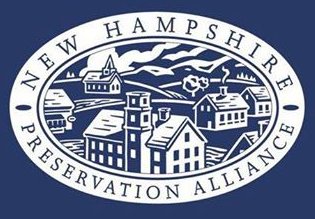Thankful for You and Positive Trends for Preservation
This Thanksgiving week we want to thank people like you who support our work and preservation activity in communities throughout the state. Without big grants or government support for operations, we rely on you to sustain and expand our activities, and we are inspired by your ideas, energy and success! Three events earlier this month showcase a few of many trends for which we are grateful:
Community members are doing incredible preservation work
Whether they are navigating grant applications, pushing for town warrant articles, baking cookies, or learning about the challenges of rising rivers or septic system design — preservation projects don’t happen without champions behind them.
A volunteer town committee in Plainfield is moving ahead on work to care for the Plainfield Town Hall (Seven to Save, 2023) and its exceptional Maxfield Parrish stage set shown here. Beverly Widger, Town Hall committee member, presents at a recent board gathering. Photo: Steve Booth
The non-profit Opera North is reviving the “Casino”, which supports its summer theater operations, at Blow Me Down Farm. The property lies along the Connecticut River with Mt. Ascutney in the background (Seven to Save, 2021). Photo: Steve Booth
Young people are showing interest in the preservation trades
Historic preservation would not be possible without the people and businesses whose refined skillset in this unique field are able to make it a reality. Our recent research revealed a severe workforce and we’re pleased that the Preservation Alliance multi-faceted initiative to address these gaps is starting to make a difference.
(Top) Recent college graduate Griffin Hotz has embraced work on old houses as an avocation and now as a vocation with Hall & Parlor Historic Preservation, LLC. Pictured here, Griffin is introducing a group of Preservation Alliance event attendees to his new old house project in Lee earlier this month. The Glidden-Towle-Edgerly House includes a late 18th century section with the central chimney and the one-room-deep federal house at right in the above photo. Photo: Jennifer Goodman
(Right) Representatives of the Preservation Alliance were excited to meet up with high school students, their parents and contractors eager to learn more about work in the preservation trades and the Preservation Alliance at the recent Bring Back the Trades Tradepalooza in Concord. Here preservation contractor Oliver Fifield engages with attendees. Photo: Althea Barton
Preservation activity provides good housing for people
In New Hampshire, we are fortunate to have a strong record of adapting old buildings for continuing uses, and key decision-makers are increasingly aware of the benefits of re-using existing buildings. The Preservation Alliance will have more to share after the holidays about a new initiative to encourage more rehabilitations.
We appreciated the current use of Rogers House (left) on the main square in Lebanon in a recent event. Built as a hotel in 1911, it provides senior housing in Lebanon and received an LCHIP grant for exterior repairs. The Lebanon Heritage Commission and Historic District Commission has been working on updating their National Register District and local guidelines and ordinances, and looking at ways to incentivize housing in the historic district, with hundreds of apartment units planned on vacant land owned by the city and on under-utilized parking lots.
The Preservation Alliance is making a difference!
Many of you use “ingredients” from the Preservation Alliance to make great things happen. We’re proud to offer field services, funds for planning and bricks and mortar grants, and a network of talented tradespeople to project proponents and homeowners across New Hampshire. It is exciting to see evidence of our Seven to Save designation providing new opportunities, our planning grants offering road maps to success, and our work over time to secure and promote tools like LCHIP and tax incentives leading to catalytic community development benefits.
This is an important foundation from which we need to do more – to reach communities that are lacking basic preservation tools and opportunities; to add tools to improve climate action and accelerate the rehabilitation of old buildings into needed housing and improve strategies for climate; and reach young people and other new constituents.
We welcome your questions and suggestions, and look forward to the work ahead.





